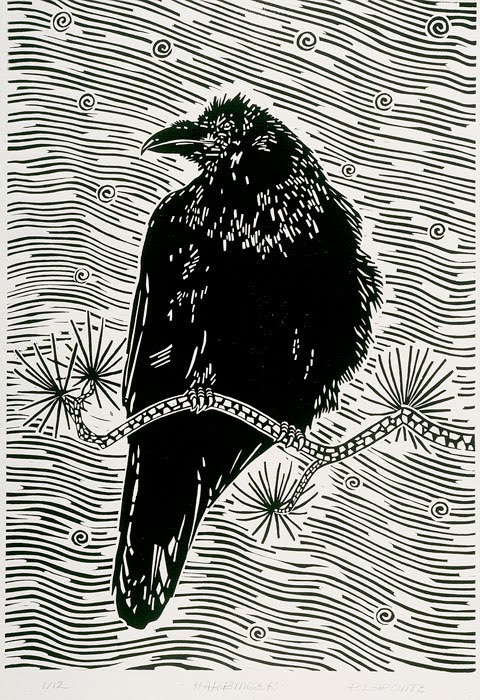Printmaking
is chosen as a form not only for its ability to create multiples, as discussed
in my last blog post, but also for the unique qualities that various
printmaking techniques offer. Paul Lapointe, a professional craftsperson with
the Saskatchewan Craft council, employs many printmaking techniques in his
repertoire as a multi-media artist. In particular, Lapointe works with
woodblock printing and drypoint etching.
 |
| A selection of carving tools, available from Lee Valley Tools |
Woodblock printing is known as “relief” printmaking. In this process one would, using carving tools such as the ones pictured above, carve out sections on the woodblock according to a pre-planned design. These areas which are carved will not pick up ink, and so the “relief”—or highest point on the block—is what will be printed. When running a roller of ink over top of the board, the carved out areas will remain white. This process can be thought of as the opposite of drawing with a marker- what you touch will not be printed, what is left behind will pick up ink. Woodblock prints can be monochromatic, or, “one-colour:” this means that the printmaker would have only printed one layer of ink (e.g, a black and white woodcut, where the “white” is the paper). Woodblock prints can also be multi-colour however; so that after printing a first layer, the printmaker would go back to the woodcut, carve more wood away, and print another colour over top of that first layer. This is called “reductive” printmaking, and works from lightest to darkest- the very last un-carved areas left on the block will be printed in the darkest ink as the layers of colour build up.
 |
| Relief printing: A represents the block, B is the paper lifting the ink away from the block. (Wiki commons) |
 |
| Harbinger by Paul Lapointe, Woodcut on paper |
Dry
point etching, in contrast, is known as an “Intaglio” printmaking technique.
This process can be considered the opposite of relief printmaking; the ‘carved’
areas are the parts which will pick up ink, as if one was to naturally draw
with a pencil. Drypoint etching is accomplished through scratching or “etching”
into a metal plate (traditionally copper) with a sharp pointed instrument.
Then, the plate is inked up. Instead of printing the plate as is, however, like
you would with the woodblock, the ink is pushed into the etching,
usually by dragging a piece of cardstock in all directions on the plate. Then a
piece of tarleton cloth is used to clean and pick up the extra ink sitting on
top of the plate. The ink should be in the plate, not on the plate, for
this technique. Then the plate is run through the printing press with slightly
damp paper (which will pick up the ink better than dry paper).
 |
| a diagram depicting how paper lifts the ink out of the depressions in Intaglio printmaking (Wiki commons) |
 |
| Mackenzie Bee by Paul Lapointe, drypoint on paper with chine-collé |
While woodcut prints
have a graphic, sharp edged feel, drypoint etchings tend to have a soft look to
them. This is primarily due to the “burr”: a rough ridge of metal thrown up on
each side of the line created by the etching tool. The result is a soft and
dark image with great potential for detail and intricacy. The different
strengths in these techniques are portrayed well by Lapointe’s work, which is
often themed around nature and its forces, animals, and landscapes.
Having grown up in Northern Saskatchewan, Lapointe’s earliest influences
were that of the natural world (SCC Membership Directory).Two great examples of these techniques are
Lapointe’s pieces Dancing Raven and Muskeg Spruce, both pieces on
view now at the SCC Boutique!
For great resources on
printmaking techniques and ideas, check out the following resources:
No comments:
Post a Comment
Note: Only a member of this blog may post a comment.